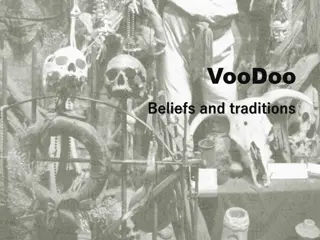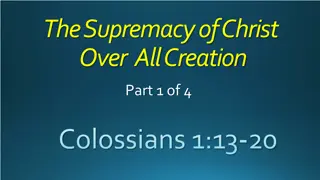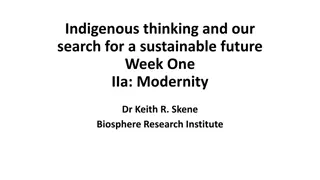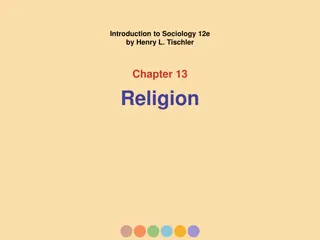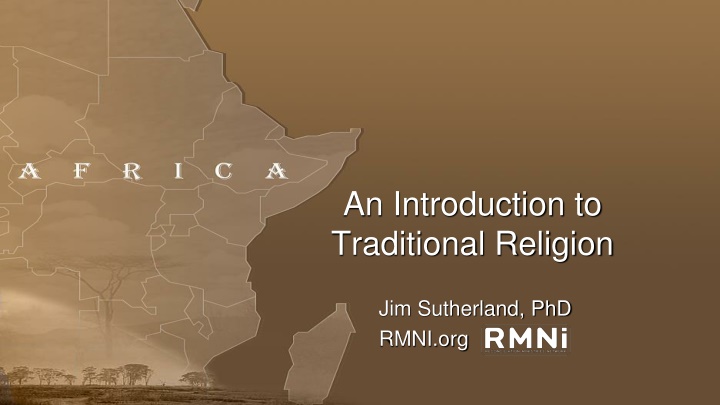
Traditional Religion: An Insight into Ethnoreligionists, Animism, and Cosmic Forces
Explore the world of traditional religions, including animism and cosmic forces, and learn about the beliefs and practices of ethnoreligionists. Discover the impact of missionaries on traditional belief systems and the encounters between Christianity and animistic religions. Delve into the charm and rites practices in cultures like Uganda and South Korea, and gain insights into the religious dynamics based on cosmic forces in both low and high religions.
Download Presentation

Please find below an Image/Link to download the presentation.
The content on the website is provided AS IS for your information and personal use only. It may not be sold, licensed, or shared on other websites without obtaining consent from the author. If you encounter any issues during the download, it is possible that the publisher has removed the file from their server.
You are allowed to download the files provided on this website for personal or commercial use, subject to the condition that they are used lawfully. All files are the property of their respective owners.
The content on the website is provided AS IS for your information and personal use only. It may not be sold, licensed, or shared on other websites without obtaining consent from the author.
E N D
Presentation Transcript
An Introduction to Traditional Religion Jim Sutherland, PhD RMNI.org
Who Are Ethnoreligionists? They are animists, polytheists and shamanists tied to an ethnic group, according to the World Christian Database. Other names are traditional religions, tribal religions, cosmic religion, or primitive religions. Ebenezer Boafo, Communicating the Message About Jesus to African Traditional Religionists, p. 1 The essence of all African traditional religions is the overlaying of our world by another world of gods, spirits of the returning dead and rites in a world where everything is alive. Boafo, p. 3
Traditional Religionists/Animists Missionaries have been quite successful in reaching animistic peoples overall: In 1900 9.2% of Africa was Christian. In 2000, 45.9% were. Population grew 626% in that period, while Christianity grew by 3,500%.1 Yet ethnoreligionists (tribal religions) were 117,537,000 in 1900 and 266,281,000 in 2009.2 In 1900 ethnoreligionists were 7.2% of the global population. In 2009, they are 3.9% of global population (World Christian Database). Their percentage is declining, while absolute numbers are increasing. 1 Michael Jaffarian, The demographics of world religions entering the 21st century, in Between past & future, J. Bonk ed. 2003, pp. 255, 260-261. 2 David Barrett, Todd M. Johnson & Peter Crossing, Christian World Communions: Five Overviews of Global Christianity, AD 1800-2025, Int l Bulletin of Missionary Research, Jan. 2009, Global Table 5, p. 25.
Religions Based on Beings Low Religions Beings on earth local gods and goddesses ancestors and ghosts spirits demons and evil spirits dead saints When Christianity confronts animistic religions, it is a power encounter.1 Deal with immediate issues.2 High Religions cosmic gods angels demons spirits of other worlds When Christianity confronts other high religions, it is a truth encounter.1 Deal with ultimate issues.2 1 Paul G. Hiebert, The Flaw of the Excluded Middle, Missiology: An International Review, 10:1, Jan. 1982, p. 40, 45. 2 Dean C. Halverson, Animism, in The Compact Guide to World Religions, Dean Halverson, ed., 1996, ISBN:1556617046, p. 40.
Charms and Rites In Uganda spouses sometimes put a picture of their spouse in a bottle and wear it, to increase love from the partner. Women will sometimes wear beads around their middle for the same purpose. In South Korea, people will put sacred words on a paper. In Uganda men and women may smoke a pipe and speak what they want to happen into the smoke. For example they might want a particular person to love them or to give them money.
Religion Based on Cosmic Forces Low Religions mana astrological forces charms, amulets and magical rites A witchdoctor gave small pieces of a lion pelt to hold for courage. evil eye, evil tongue In the DRCongo, the oola is the evil eye from certain women. It s believed that if they look at a baby it starts to cry and then dies. witchcraft High Religions kismet fate Brahman and karma impersonal cosmic forces predestination Paul G. Hiebert, The Flaw of the Excluded Middle, Missiology: An International Review, 10:1, Jan. 1982, p. 40.
Power Encounter Huntington Mammu is an elder at Ntenjeru Community Presbyterian Church, near Kampala, Uganda. He purchased land that had a stone on it considered to have power ( mana ). People who approached that stone brought money, out of respect. He couldn t find anyone to clear the new property, due to fear of this large stone, so he cleared it himself. But he offered nothing to the stone. Two weeks later he was near the stone and a cobra bit him. He called out to the Lord, ate onion, but deliberately did not go to a doctor, since he considered it demonic. He was not hurt.
The Excluded Middle Hiebert points out that Christian missionaries from the West have been able to help concerning matters of eternity and matters of human society (family, marriage, other social relations). But, at least in the past, they haven t been able to give alternatives to tribal religionists who go to the witchdoctor or shaman for guidance and protection from evil spirits, or for help in times of crises. What does Christianity say about getting rain for the crops, knowing to whom to give a daughter in marriage, or how to counter magic directed against you? This middle area was not adequately addressed. Hiebert, p. 44
Taking Spirits Seriously Rodney Henry, in The Filipino Spirit World relates that there is a conspiracy of silence among laypeople in that they don t go to clergy about spirits, because they don t think the clergy will take them seriously. Henry wrote of a layman who went to an American missionary to pray for a friend who was troubled by demons. The missionary laughed and began talking about something else. Dean C. Halverson, Animism, in The Compact Guide to World Religions, Dean Halverson, ed., 1996, ISBN:1556617046, p. 43.
Folk Religions All major religions have those who mix their beliefs with animistic ones, on the level of daily living. For example: Most Muslims rely upon holy men marabuts who head Sufis, etc. for their prayers, breath and even spittle for miraculous intervention. They also look to saints, both living and dead, for their intervention when in need. Sacred objects, such as trees and rocks, are associated with saints. Also relics from holy men are used as a talisman against the jinn evil spirits, generally, and to protect from the genie or devil-mate. Norman Anderson, Islam, Ch. 9 in The World s Religions, pp. 113-114, Inter-Varsity Press.
Generally Held Animistic Beliefs A supreme creator god has been offended by those, so god abandoned humankind, and is now inaccessible, even by prayer The chief god may be named the Sky God or Supreme God. Lesser gods are those with whom tribal religionists deal. They were created by the high god and live in inanimate things, but can indwell animals. (Boafo, p. 3) Lesser gods live in towns or are served by families or individuals. Boafo, p. 3
Personal Spirit Beings Those that have bodies, including dead ancestors Those that do not have bodies, such as spirits and gods. These spirits are seen as helpers in life, or those that hinder us, if they are not given honor. Dean C. Halverson, Animism, in The Compact Guide to World Religions, Dean Halverson, ed., 1996, ISBN:1556617046, p. 40.
Personal Spirits Spirits have local power, rather than universal power. Some exercise power over people. They may influence business deals, marriage, relations with others, etc. Some spirits influence, or seem to influence, nature. Sacrifices are made to the river god in S. Sudan and Uganda. They seem to control rain, or harvests, etc. Dean C. Halverson, Animism, in The Compact Guide to World Religions, Dean Halverson, ed., 1996, ISBN:1556617046, p. 41.
Impersonal Spirits These are believed to indwell inanimate objects. This concept is called mana. Additionally, spirits may inhabit words or ritual practices. Dean C. Halverson, Animism, in The Compact Guide to World Religions, Dean Halverson, ed., 1996, ISBN:1556617046, p. 41.
Concept of Sin Sin, for the African traditional religionist, is not a state of being, as in Christianity. Rather, it is primarily blasphemies or breach of vows against the gods or ancestors. Murder, theft and all offences against persons or property are matters which have to be settled primarily by the family and society (Williamson, 107). It would appear that the gods and ancestors are mainly concerned about their dignity and about offerings to be paid to them, and that man s concerns must be rectified and punished by man. Boafo, p. 3
Divination To find out information about spirits and the future and other matters of interest, divination is used. These methods include: astrology, reading entrails of animals, using special stones, and astrology. They also may include tarot cards, palm reading, the I Ching, tea-leaf reading, observing how feathers fall, the throwing of cowrie shells necromancy (contacting the dead) and interpreting dreams and visions. Leviticus 19:26 "'Do not practice divination or sorcery. NIV cf. Dt. 18:10. Dean C. Halverson, Animism, in The Compact Guide to World Religions, Dean Halverson, ed., 1996, ISBN:1556617046, p. 40
The Afterlife At death, a person s spirit returns to the Supreme Being, in African traditional religion. The person s soul goes on to the spirit world, which is like life on earth, and the departed is considered part of the clan. Of course, now they must be kept happy. Alternately, some animists believe in reincarnation. Boafo, p. 2
The Gospel for Animists Christians have a great alternative to offer: freedom from bondage to spirit beings, including ancestors and evil spirits. freedom from impoverishing family by offerings to appease gods and from paying shamans/medicine men and women. forgiveness for sins, which animal sacrifices cannot accomplish. Hebrews 10:4 because it is impossible for the blood of bulls and goats to take away sins. Hebrews 9:28 so Christ was sacrificed once to take away the sins of many people
How to Reach Animists Paul Hiebert advocated two ways: (1 a more holistic ministry dealing with the comprehensive needs of people (2 not going to the extreme of turning Christianity into a form of magic, trying to control beings with impersonal forces, such as formulae saying the right words. Hiebert, pp. 45-46
Why Knock on Wood? The explanation we prefer is the ancient belief that spirits either dwelled in or guarded trees. We prefer this because many cultures around the world show evidence of tree worship dating back thousands of years. Greeks worshipped the oak as it was sacred to Zeus, Celts believed in tree spirits, and both believed touching sacred trees would bring good fortune. Irish lore holds that touching wood" is a way to thank the leprechauns for a bit of luck. Pagans also held similar beliefs of protective tree spirits. Chinese and Koreans thought the spirits of mothers who died in childbirth remained in nearby trees. 1 10% of US teens have been in a s ance and 8% have cast a spell or concocted a potion.1 1 Ask Yahoo, http://ask.yahoo.com/20040504.html accessed 5/30/09 2 1/23/06 Barna Report www.barna.org/barna-update/article/5-barna-update/164-new-research-explores-teenage-views-and-behavior- regarding-the-supernatural
Folk Christianity Christians may try to control God or spirits Praise goes up, blessings come down. This is a form of attempted manipulation. Some think that by reciting the names of God such as Jehovah Jirah that God is somehow obligated to express that attribute toward the one naming the attribute. Some give seed money to the church to cause God to give much more in return. African Americans have the highest rates of reading horoscopes, church attendance and Bible reading. Barna Group 6/23/03 http://www.barna.org/barna-update/article/5-barna-update/123- fragmented-populations-require-diverse-means-of-connection
Folk Christianity & Chance Christians are more likely to invest their money in lottery tickets than are non-Christians. Overall, 15% of born again and 23% of notional Christians purchased lottery tickets in a typical week, compared to just 10% of other-faith adherents and 12% of atheists/agnostics. Looking to chance for provision? 5/24/04 http://www.barna.org/barna-update/article/5-barna-update/188- faith-has-a-limited-effect-on-most-peoples-behavior

